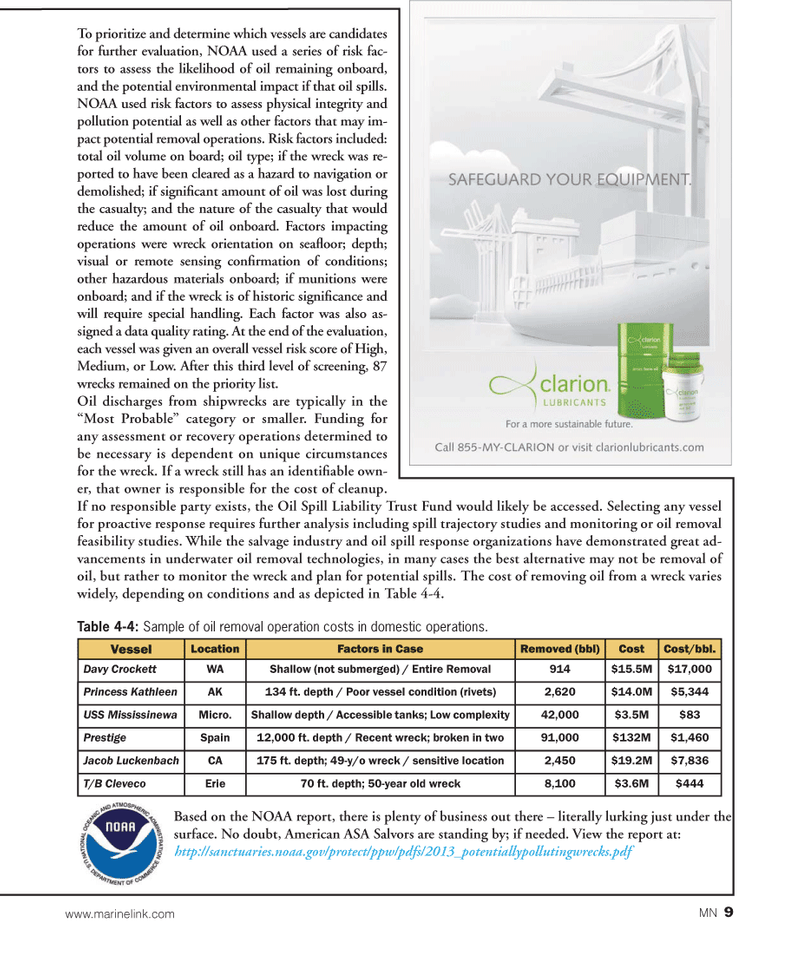
Page 9: of Marine News Magazine (August 2013)
Salvage & Response
Read this page in Pdf, Flash or Html5 edition of August 2013 Marine News Magazine
To prioritize and determine which vessels are candidates for further evaluation, NOAA used a series of risk fac- tors to assess the likelihood of oil remaining onboard, and the potential environmental impact if that oil spills. NOAA used risk factors to assess physical integrity and pollution potential as well as other factors that may im- pact potential removal operations. Risk factors included: total oil volume on board; oil type; if the wreck was re- ported to have been cleared as a hazard to navigation or demolished; if signi? cant amount of oil was lost during the casualty; and the nature of the casualty that would reduce the amount of oil onboard. Factors impacting operations were wreck orientation on sea? oor; depth; visual or remote sensing con? rmation of conditions; other hazardous materials onboard; if munitions were onboard; and if the wreck is of historic signi? cance and will require special handling. Each factor was also as- signed a data quality rating. At the end of the evaluation, each vessel was given an overall vessel risk score of High, Medium, or Low. After this third level of screening, 87 wrecks remained on the priority list. Oil discharges from shipwrecks are typically in the Most Probable? category or smaller. Funding for any assessment or recovery operations determined to be necessary is dependent on unique circumstances for the wreck. If a wreck still has an identi? able own- er, that owner is responsible for the cost of cleanup. If no responsible party exists, the Oil Spill Liability Trust Fund would likely be accessed. Selecting any vessel for proactive response requires further analysis including spill trajectory studies and monitoring or oil removal feasibility studies. While the salvage industry and oil spill response organizations have demonstrated great ad- vancements in underwater oil removal technologies, in many cases the best alternative may not be removal of oil, but rather to monitor the wreck and plan for potential spills. The cost of removing oil from a wreck varies widely, depending on conditions and as depicted in Table 4-4. Table 4-4: Sample of oil removal operation costs in domestic operations. Based on the NOAA report, there is plenty of business out there ? literally lurking just under the surface. No doubt, American ASA Salvors are standing by; if needed. View the report at: http://sanctuaries.noaa.gov/protect/ppw/pdfs/2013_potentiallypollutingwrecks.pdf Vessel LocationFactors in CaseRemoved (bbl)CostCost/bbl. Davy Crockett WAShallow (not submerged) / Entire Removal914$15.5M$17,000 Princess Kathleen AK134 ft. depth / Poor vessel condition (rivets)2,620$14.0M$5,344 USS Mississinewa Micro.Shallow depth / Accessible tanks; Low complexity42,000$3.5M$83 PrestigeSpain12,000 ft. depth / Recent wreck; broken in two91,000$132M$1,460 Jacob Luckenbach CA175 ft. depth; 49-y/o wreck / sensitive location2,450$19.2M$7,836 T/B Cleveco Erie70 ft. depth; 50-year old wreck8,100$3.6M$444 MN 9www.marinelink.com MN August2013 Layout 1-17.indd 97/23/2013 7:40:05 PM

 8
8

 10
10
